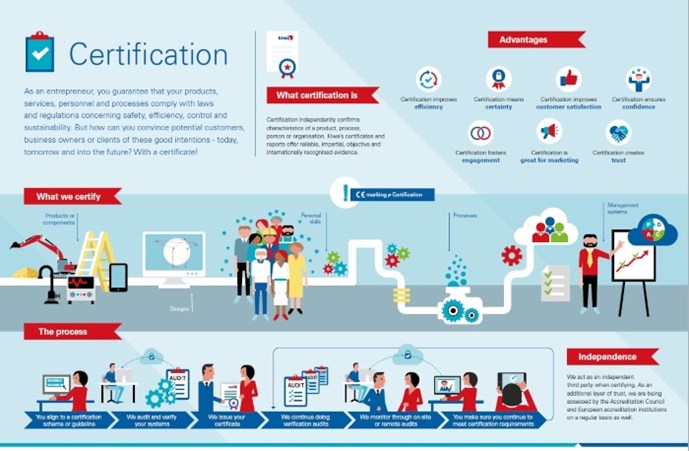4 tips to make a mark with your certificate
Congratulations – you’re certified! There is more to that than just reflecting your compliance with a quality standard. Here are four top tips for making the most of your certification through marketing.
Certification shows that your business – with its products, services, processes or systems – meets a certain standard’s requirements. This is not only good for the quality of your operations, but it also strengthens relationships with your customers, investors and other stakeholders. Companies that hold third-party certification have an edge with their clients. If you’re one of these companies, are you making the most of that edge?
“Certificates are not only things you can frame and hang up; they also come with recognizable icons you can place on your website, your product and, for example, even on your transport,” said George Mentjox, Corporate Communication Manager at Kiwa. “These icons have proven their value for many companies and organisations, so we are convinced they help to give your business an extra boost.”
There are numerous more ways you can put your certification in the spotlight and showcase the quality it reflects. These top tips will help you make your certification work hard for your company through marketing.
1. Get your facts straight
What does your certification say, and what can you say about it? You’ve put a lot of work into making sure your product, service, system or process meets the required standards to earn the certificate, so it’s a good idea to make sure you get your message straight before you start shouting it from the rooftops.
There’s a difference between a certificate and a mark. For example, if you’ve earned the CE mark, it’s a good thing to stamp it on your products being traded in Europe, but it doesn’t say much about the quality of your business and doesn’t set you apart from the competition. On the other hand, being awarded something like an ISO 14001 certificate proves that your business operates in a way that protects the environment – something your competitors may not be able to.
2. Let your certificate do the talking
Research has shown that marketing is most effectively done through other people’s positive messages, such as by word of mouth – people trust their friends, peers and independent third parties more readily than they do companies they might not know.
Being awarded a certificate by a certification body puts you in a great position – after all, it is effectively an independent third party saying something positive about your company. Independent certification bodies act as a third party between producer (you) and consumer (your customer). And since someone’s already done the talking, you can share their message rather than shaping your own.
3. Spread the word
“Implementing ISO standards is a way to improve quality management and to communicate this improvement to customers,” said Alan Bryden, former Secretary General of ISO. And the communication is key – certification helps you improve quality, but your customers will only know about that if you tell them.
When you receive the certification, you could announce it with a press release, newsletter article, email announcement, news article on your website and social media posts. Think about all the communication channels at your disposal. You could add the relevant stamp, logo or wording to traditional printed materials, such as flyers and business cards, and in any advertisements you place. As well as a dedicated webpage with an electronic copy of the certificate, you could also add a note to the footer of every web page, with a link to the certification body. But don’t limit yourself to standard channels – why not add a logo or a few words to the side of your vehicles, your LinkedIn company page, quotations or invoices, or hang a flag or have mugs printed for your next conference? Or, a simple but very effective way: frame and hang your certificate on the wall at the entrance of your office.
Don't forget to communicate your certification internally as well. Show and tell in an article on the intranet or inform colleagues by email. Motivate them to share the news via their personal social media, for example LinkedIn. Make appealing content available for this, such as an article on your website they can share, including some great photos. You might even want to hold a celebratory reception to announce it and thank everyone involved in the process.
4. Engage your stakeholders
When you communicate with your stakeholders, you’re not just throwing a message into the abyss. Getting feedback from your stakeholders will help you shape your message and make sure you’re talking to the right people through the right channels. Monitor the effectiveness of your communications by keeping track of website hits, advertising conversion rates and social media engagement. You could also ask your stakeholders whether they noticed your certification and what they thought of it through a short online survey. Their input will help you develop an outreach plan for your next certification, and make your customers feel more involved.
Certification makes your credibility visible
You can tell that your products, services, processes and organization meet all quality standards, but certification makes it visible! In some cases it can even be required by regulation or law. How does certification work, what do we certify and what are the advantages? This infographic tells you more:
Download PDF by clicking on the image




